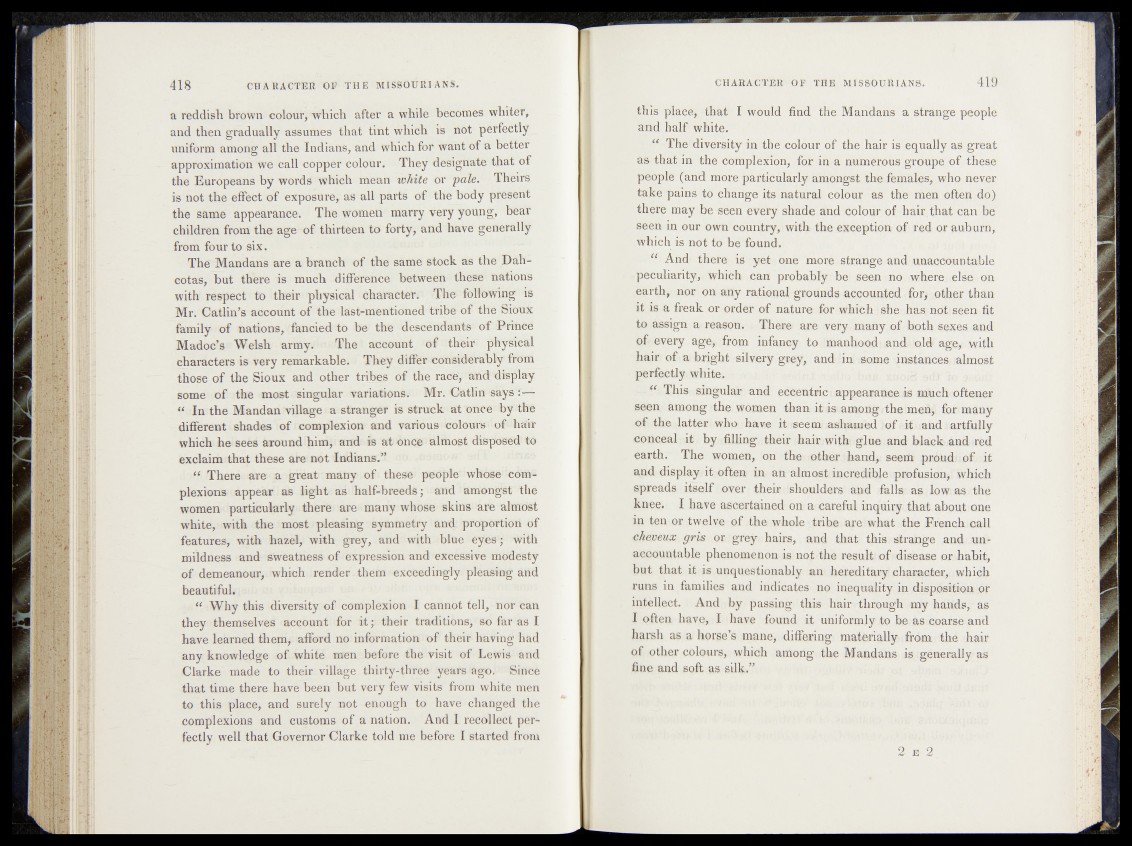
a reddish brown colour, which after a while becomes whiter,
and then gradually assumes that tint which is not perfectly
Uniform among all the Indians, and which for want of a better
approximation wé call copper colour, i They designate that of
the Europeans by words which mean white or pale. Theirs
is not the effect of exposure, as all parts of the body present
the same appearance. The women marry very young, bear
children from the age of thirteen to forty, and have generally
from four to six.
The Mandans are a branch of the same stock as the Dah-
cotas, but there is much difference between these nations
with respect to their physical character. The following is
Mr. Gatlin's account of the last-mentioned tribe of the Sioux
family of nations, fancied to be the descendants ofPrinee
Madoc’s Welsh army. * The account of their physical
characters is very remarkable. They differ considerably from
those of the Sioux and other tribes of the race, and display
some of the most singular variations. Mr. Gatlirr says f—7
« In the Mandan village a-stranger is struck
different shades of complexion and variousJcolours ir f hatir
which he sees around him, and is at once almost disposed- to
exclaim that these are not Indians.”
“ There are a great many of these people whose cém<-
plexions appear as light as half-breeds; and amongst thé
women particularly there are many whose skins are almost
white, with the most pleasing symmetry and proportion of
features, with hazel, with grey, and with blue eyes1; with
mildness and sweatness of expression and excessive modesty
of demeanour, which render them exceedingly pleasing and
beautiful.
“ Why this diversity of complexion I cannot tell, nor can
they themselves account for it; their traditions, so far as I
have learned them, afford no information of their having had
any knowledge o f white nren before the visit of Lewis and
Clarke made to their village thirty-three years ago. Since
that time there have been but very few visits from white men
to this place, and surely not enough to have changed the
complexions and customs of a nation. And I recollect perfectly
well that Governor Clarke told me before I started from
this placé,-that I w&uîd find the Mandans a strange people
and half whited
The diversity in the Colour of the »hair is equally as great
Us that in the complexion, for in!a numerous groupe of these
people (and more particularly amongst theffemales, whomever
take pains to chaife its natural ;<jPphr as thefmen often do)
there may be seen every shade and colow>pf tbair, that ■ can h e
seen in our own country, witb the exception of red or auburn,
which is not fô^he found,
“ And there is yet-one 'more strange and. unaccountable
.peculiarity, which can probabîÿfhbftseen :-no_ where hlsefiPn
earth, nor on any rational grounds -accounted < for, other than
it is a freak or order of nature for which ?she has; not;, seen; fit
to assign a- reason. There are wery many of both sexes and
of every ag%r;from infancy to manhoodsjüandfi!old age* * with
hair of'»bright silvery grey, and insfasicesyalmost
perfectly, white.
Ilhisi singular" and eeeentrieisppearaneeii© nÉjchtoffceaef
seen among the women than it is among Ahe imeiÿ for many
of the latter who have it ;geem> ashamed jof it an d ‘.artfully
conceal it by filling their hair; with glue and blaek and red
earthr The women, on tfre> other 'hand,; seeih prèjLidïiof J t
and displayrit often in an almost incradil^eiprofushiml which
spreads itself over their r Shoulders and falls as low-as the
knee. I have ascertained on; a careful inquiry that about,»one
In ten or twelve of the whale triberàfe what the Eraocbioall
4keneux gris or rgrey, hairs, and that Ihis dtrarige and; un -
accountable phenomenon is not the result; of disease or habit,
but that it is unquestionably am hereditary eharjpfeer, which
runs in \ families and indicates no inequality in disposition or
intellect. And by passing, this hairTthrough ray hUMds,* as
I often have, I have found it uniformly to be/as coarso and
harsh as a hor#e’s mane,-diffe*iugi mat«i^llyjtfrom the hair
of other colours, which among the Mandans is generally as
fine and soft as silk.”